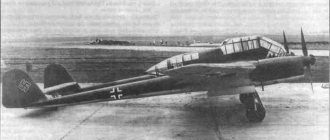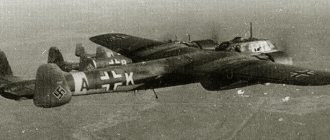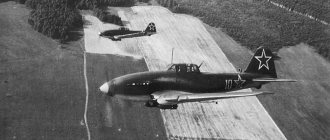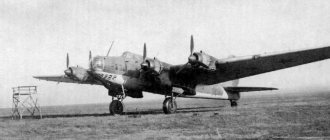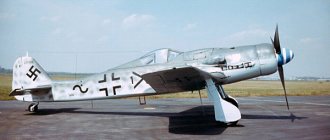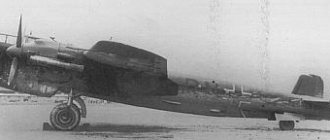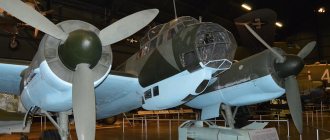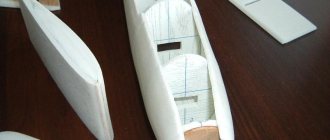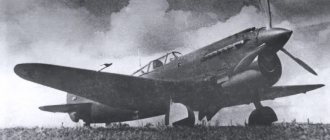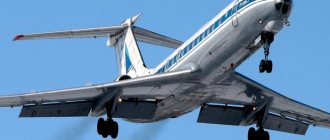Photo of Hawker Typhoon fighter-bomber
The success of the Hawker Hurricane fighter was to a certain extent unexpected even for its creator S. Camm - after all, he considered the Hurricane only as an interim solution before the adoption of a fighter with higher performance characteristics.
Already at the end of 1936, the requirements for such a machine, formulated in specification F. 18/37, were agreed upon with the Ministry of Aviation. It envisaged the creation of an all-metal single-seat fighter capable of reaching a speed of 640 km/h and armed with 4 20-mm cannons or 12 7.7-mm machine guns. It was planned to install a new 24-cylinder liquid-cooled engine on the aircraft. The development of such engines began (Walcher) and Napier (Sabre). Accordingly, aircraft designer Camm designed a new fighter in two versions: R (later called “Tornado”) for the Walcher engine and N (“Typhoon”) for the Saber.
The Typhoon prototype first flew on February 24, 1940, almost five months after the Tornado flyby, but the latter never made it into production. The reason was Rolls-Royce’s workload with the production and modernization of the Merlin, the most popular aircraft engine in the UK. Because of this, the program for creating “Walcher” had to be curtailed. The development of the Typhoon also slowed down after the “Dunkirk shock” - the Royal Air Force primarily needed the already proven Hurricanes and Supermarine Spitfires.
The second prototype, armed with 4 20-mm cannons, entered testing only on May 3, 1941, and on May 27 the first production vehicle took off. Although cannon armament had by that time clearly proven its superiority over machine guns, due to the lack of development of the shell feeding mechanism, it was necessary to release a series of “Typhoons” with machine gun armament.
Aircraft production continued until May 1945. 3,317 Typhoons were built, and in addition to prototypes, Langley produced only 15 production aircraft in November-December 1941. The rest were built in Hucklecote.
Main modifications of the Hawker "Typhoon"
- "Typhoon" Mk .IA - Saber I engine (2100 hp). Armament: 12 7.7 mm Browning machine guns in the wing. 110 vehicles were built, some of which were later re-equipped with guns.
- "Typhoon " Mk . I B - Saber engine I. Armament - 4 20-mm British Hispano Mk.II cannons. The aircraft could carry two aerial bombs with a caliber of up to 454 kg, or 8 76.2-mm NAR, or two 175-liter PTB. During production, changes were made to the design. In particular, the aircraft received a teardrop-shaped canopy instead of a “car-type” canopy (with a side door), which significantly improved visibility. More powerful Saber IIA and IIB engines (2180 hp) were installed, and at the very end of serial production - Saber IIC (2260 hp) with a four-blade propeller instead of a three-blade one.
The Typhoon NF Mk.IB night fighter with the Al Mk.VI radar, as well as the Typhoon FR Mk.IB reconnaissance aircraft with the AFA in the left wing console (instead of the gun closest to the fuselage) were not introduced into mass production.
Technical characteristics of the Hawker Typhoon Mk.IB aircraft
- Engine: Napier Saber II
- power, hp: 2180
- Wingspan, m: 12.67
- Aircraft length, m: 9.74
- Aircraft height, m: 4.67
- Wing area, sq. m.: 25.90
- Weight, kg:
- empty aircraft: 3992
- takeoff: 5216
- maximum takeoff: 5850
- Maximum speed, km/h / at altitude, m: 663/5880
- Climb time 4572 m, min: 5'50"
- Practical ceiling, m.: 10730
- Flight range, km. (with PTB): 820* (1580)
* with two 227 kg aerial bombs.
Combat aircraft. A typhoon after a hurricane or a third wheel... almost a Focke-Wulf
This is the case when the third one could really turn out to be superfluous.
And the culprit for it all was Sidney Camm, an odious and brilliant personality at the same time. Yakovlev and Tupolev in one bottle, if such a comparison does not offend anyone. Camm's intelligence and desire to create for the benefit of his country resulted in the fact that work was carried out simultaneously on several projects. According to the recollections of Hawker employees, sometimes “hell reigned in the offices...”.
The problem was that there was no point in arguing with Camm; you could either work on projects or run away without looking back.
Sydney Camm, not yet Sir
Camm, created the Hurricane, that is, the Hurricane, which became the main force in the path of the German armadas in the Battle of Britain.
Yes, the plane was more than ambiguous, but it was there. And then the Spitfire appeared. And Camm realized that the Hurricane’s life would be short-lived, and already before the war he began negotiations with the Ministry of Aviation that he would begin to develop a new aircraft to replace the Hurricane.
The Technical Development Directorate reacted favorably to Camm's idea. But when Camm and representatives of the Ministry of Aviation voiced their desires, battles began, since the visions of Camm and the representatives of the Directorate were somewhat different. More precisely, they differed very significantly.
Camm planned to create a mass-produced universal fighter to replace the Hurricane, but the Ministry of Defense wanted to see an aircraft that would stand on par with the Spitfire. Not replacing it, but complementing it.
According to the plans of the British aviation leadership, a certain fighter-interceptor was required, an aircraft not focused on maneuverable combat, but intended for battles with bombers and heavy twin-engine escort fighters.
That is, instead of maneuverability - speed, height and heavy weapons.
By the way, the Battle of Britain that unfolded later confirmed these calculations: the maneuverable Bf.109 did not have the proper range, and the entire burden of protecting German bombers during raids on British cities fell on the wings and machine guns of the Bf.110, which were just that, twin-engine and not intended for the “dumping ground”.
We know how the battles in the skies of Britain ended.
Well, the armament of the new aircraft would have to be different from that of the Hurricane.
Camm planned to install a terrible battery of 12 7.69mm machine guns on the plane. But even then, the British Ministry of Aviation understood that the future belonged to armored bombers and 7.69 mm machine guns would be frankly weak.
Actually, this is what happened in the future. But already in 1938, the Ministry of Aviation insisted that Camm review the armament of the new aircraft towards a cannon one. Guns seemed a more realistic weapon against bombers.
Throughout the year, there were disputes regarding the role of the new aircraft, but in the end, figures from the ministry won: the aircraft was destined to become an interceptor fighter with a very powerful cannon armament for that time.
Then the now classic torment of creativity with engines began. Camm and the Ministry decided that the aircraft should have the strongest engine possible, with a power of about 2,000 hp. And it was very tempting to try something completely innovative and experimental.
For example, "Saber" from . It was a very interesting engine, an H-shaped, 24-cylinder water-cooled engine. The engine promised very high performance, despite the fact that there were indeed a lot of innovations in it. For example, valveless sleeve gas distribution.
The second contender was the Walcher from Rolls-Royce. It was also a very original design, an X-shaped motor, created by mounting on one shaft two V-shaped Peregrin motors, which had long been mastered in production and promised at least reliability.
Both engines were under development, that is, they were very “raw”, although promising.
As a result, work on the new aircraft proceeded at a fairly calm pace. Thunder struck on January 15, 1938, when ten aircraft manufacturing companies received an offer to participate in a competition to create an interceptor aircraft with clearly defined characteristics: fast, high-altitude, with a good rate of climb and armed with four 20-mm cannons. There was no flexibility in priority requirements.
The hell of creation began in the Hawker and already on April 22, the ministry was offered TWO fighter-interceptor projects. The first was designated "Type R" and was powered by a Rolls-Royce Walcher engine, the second was called "Type N" and its heart was a Napier Saber.
The ministry liked the projects and Hawker ordered two prototypes for testing. The plane with the Walcher was called "Tornado", and the one with the Saber - "Typhoon".
"Tornado"
"Typhoon"
In fact, it was the same project with the nose section significantly redesigned for engines. The aircraft retained the steel tubular space frame of the Hurricane, but were noticeably increased in size.
Unlike the Hurricane, the new aircraft were all metal. The monocoque became completely metal, while the duralumin skin of the wings took on part of the load on the wing.
The planes turned out to be similar, only there were differences in the nose: the Typhoon had a characteristic “beard” from the water radiator, which was located under the engine, and the Tornado had a radiator placed in the same way as the Hurricane, in an armored bath under the center section. And the exhaust pipes were laid out differently: the Saber had one row, the Walcher had two rows.
Since the Ministry had ordered the construction of two copies of each model, Camm decided to build aircraft with different types of weapons. “Model A” was armed with 12 machine guns, “Model B” - four 20-mm Hispano cannons.
An interesting feature was the implementation of a glass anti-freeze system, which was very useful for long flights at high altitudes. The transparent cockpit glazing panels were made of double panels: the first one was made of armored glass 38 mm thick, the second one was made of armored glass 5 mm thick. Hot and dry air from the engine was supplied between them, which completely prevented icing of the glass.
The Tornado was the first to be lifted into the air. The Walcher engine was ready a little earlier than the Saber, plus the Typhoon under construction was severely damaged by a German bomb that accidentally flew into the Kingston plant. In general, the Germans tried to bomb a nearby railway, but ended up in a well-camouflaged factory.
So the Tornado flew first. This happened on October 6, 1939. The flight characteristics of the aircraft turned out to be simply excellent, however, at high speeds over 650 km/h, aerodynamic drag increased significantly. The radiator bath turned out to be to blame, and the Tornado was equipped with a radiator like the Typhoon. Flight performance has improved significantly.
The Typhoon took off on February 24, 1940. The plane was not bad, but it was necessary to return it to the factory and modify the tail unit, since the prototype behaved unstable in flight.
They did the same with the plumage on the Tornado. As a result, the planes became even more similar to each other.
The Ministry of Aviation had an interesting plan for the construction of aircraft. It was planned to build about 1,000 aircraft by September 1941 in the following proportion: 500 Tornados, since the Walcher seemed more reliable, 250 Typhoons, and 250 of the model that turned out to be better in operation. “Typhoon” and “Tornado” were supposed to be assembled in parallel.
However, in May 1940, the British Air Ministry, through the mouth of Minister Lord Beaverbrook, announced that the “program of five” was being introduced. That is, all industrial efforts are concentrated on the production of Hurricane and Spitfire fighters and Wellington, Whitley and Blenheim bombers.
Production on Typhoon and Tornado was delayed until almost after the end of the Battle of Britain.
On May 5, 1940, the second Typhoon took to the skies, and on December 5, the second experimental Tornado. Both aircraft were armed as “B” type, that is, with cannons in the wings. The first prototypes had machine guns. A practical testing program has begun.
And as a result of these tests, “Tornado” left the race. The engine failed him. "Walcher" never became an engine that could be considered reliable. Even replacing the "Walcher II" with the more powerful "Walcher V" did not give the expected results.
As a result, being very busy with the modernization of Merlin, she became disillusioned with Walcher and stopped work on its debugging. Along with the Walcher, the Manchester bomber project also left, which was replaced by the Lancaster with four Merlins.
Therefore, “Tornado” did not go beyond the prototype. In addition to the prototypes, only one production aircraft was produced, which was used in bench tests. And the developments on the Tornado, including experiments on installing various engines (Wright R-2800, Bristol Centaur and Fairy Monarch) were useful when working on Tempest. But that is another story.
And “Typhoon” was also put aside for a short time, as it turned out. The order for the interceptor could have easily been cancelled, but the Germans helped. At the end of the summer of 1941, the Focke-Wulf FW.190A debuted on the Western Front, which made life much more difficult for the Spitfire pilots. We won’t even talk about Hurricanes.
The Focke-Wulfs had to be opposed to something, and to do it immediately. And then they remembered “Typhoon” in time. In the spring of 1941, serial construction of the aircraft began, and on May 27, the first production Typhoon took to the skies.
True, the aircraft's armament consisted of 12 machine guns. It was very prudent on Camm’s part to develop such a scheme, because it was not possible to arm the planes with cannons. There was a shortage of belt feeding mechanisms for projectiles, which were produced in France, in Chatellerault, under license. The production of all components for the Hispano guns took a lot of time and effort.
In addition to machine guns, the first Typhoons had an opaque gargrot behind the cockpit and Saber I engines.
The engine did not pull. Yes, it was more reliable than the Walcher, but with the Saber the fighter accelerated only to 620 km/h, while calculations promised 750 km/h, and the ministry was not so optimistic and expected a speed of 645 km/h Only towards the very end of the series, after a number of modifications, the speed was raised to 663 km/h. The rate of climb was also insufficient.
The engine became the Achilles heel of the aircraft. Saber provided a resource of no more than 25 hours. This is more than in the first tests, when the engine worked for no more than 10 hours, but still catastrophically short. But often the Sabers broke down without working even 25 hours.
During flight, the Saber often overheated and became jammed when climbing. It could have ignited on takeoff. If we take into account that there were lines from the gas tanks next to the pilot’s seat, then finding that there was smoke coming from under their feet, the pilots jumped out of the cockpits even at the start. Sometimes this was very, very justified.
Another headache in the truest sense of the word was the exhaust gases that entered the pilot’s cabin through the partition between the engine and the cockpit. The pilots had the opportunity to be poisoned by exhaust fumes. Gases also passed through a manifold, which diverted them to heat the machine guns.
Work was carried out, the manifold and bulkhead were sealed, the exhaust pipes were lengthened, but this partially solved the problems. Therefore, over time, British pilots became accustomed to the fact that an oxygen mask must be put on before starting the engine.
Another problem was flutter, which appeared at relatively low speeds.
However, the Typhoon was needed in the air during World War II, so having quickly eliminated the main shortcomings, the British launched the aircraft into production and began delivering it to combat units.
The haste caused by necessity gave rise to a not entirely good perception of the aircraft in units. The pilots were poisoned by carbon monoxide, burned, and the planes very often got into accidents and disasters. The first 142 Typhoons were reported to have 135 accidents in combat units.
It cannot be said that everyone at the manufacturing company looked at this calmly. Hawker sent all of its test pilots to combat squadrons as instructors. Hawker and Gloucester, which also produced Typhoons, sent their factory crews to the airfields to work more closely with the Air Force.
Yes, initially the flight crew was not at all enthusiastic about the new aircraft. The Typhoon was fast, but heavy and very unreliable. Not the Spitfire, which enjoyed well-deserved love among British pilots. The commander of one of the squadrons rearmed with Typhoons, R. Beaumont, expressed the opinion that the best role that the Typhoon could play was not as an interceptor, but as an attack aircraft.
But the Typhoons were sent to serve in the south of Britain to counter German air raids. Including the Focke-Wulfam.
Success, to be honest, did not come immediately. In late 1941 and early 1942, the Germans used infiltration tactics at ultra-low altitudes to avoid being detected by the British radar system. At altitudes below 3000 meters, the Typhoon was superior to the Focke-Wulf in speed, but as soon as the planes rose above 6000 meters, all the advantages of the Typhoon disappeared.
In the end, everyone came to the conclusion that the Typhoon was not very good as an interceptor. Plus there are constant engine breakdowns. The Spitfire, especially the IX model, coped with intercepting German aircraft no worse, and in some cases even better, than the Typhoon.
It is quite reasonable that the Ministry of Aviation thought about whether the Typhoon was needed at all.
Meanwhile, the production of aircraft and the equipping of flight units with them continued. And one of the options for using the aircraft was the proposal that Beaumont made. That is, the use of the Typhoon as an attack aircraft.
It was assumed that the Typhoon would replace the assault modifications of the Hurricane behind the Western Front, where the British had already begun to operate along German communications.
It turned out that the Typhoon has two qualities necessary for an attack aircraft: powerful weapons and good speed. That is, the plane could quickly enter the area of operation, shoot at targets and just as quickly escape.
Four guns with a decent rate of fire were equally good at destroying everything that came into their sights: river barges, boats, locomotives and trucks. In general, it turned out to be a kind of “Focke-Wulf” in reverse. With a plus sign.
By the summer of 1943, the 609th squadron on Typhoons had reliably shot more than a hundred steam locomotives in France and Belgium.
The powerful Saber, which was finally brought to fruition, allowed us to work miracles. Hang additional 300 liter fuel tanks? No problem, we fly on. 227 kg bombs? Easily. American 454 kg? We puff, but we drag on. Cassettes with small fragmentation bombs, smoke bombs, mines - the Typhoon regularly carried and dropped everything.
Camm, who went into a rage, tried to increase the number of guns to six, but they decided to spare the wing and not load it, for fear of deteriorating flight properties.
But the missiles took root well on the Typhoon. The same 76 mm caliber that were used with Mosquito, Beaufighters, Hurricanes and Swordfish. The missiles were not particularly accurate, but they were cheap to produce and could be produced in the thousands.
Since 1943, all “Typhoons” were produced only in a cannon version, the barrels received fairings, and “Aerocobra”-type “car” doors gave way to a conventional sliding canopy.
And “Typhoon” really started playing.
The attack aircraft's finest hour was 1944, when a few days before the Allied landings in Normandy, 22 Typhoon squadrons shot up German radar stations on the coast, making it much more difficult to detect ships carrying landing forces.
After the landing, the Typhoons did not stand idle. They were brought in to provide direct support to the troops. In fact, they played the role of Il-2 in the Red Army Air Force. Typically, Typhoons patrolled close to the battlefield at an altitude of about 3000 m. At the commands of the aircraft controller on the front line, they attacked armored vehicles, artillery positions, pillboxes and bunkers.
Of course, it was almost impossible to hit a tank or pillbox with a missile from a diving fighter, but it had a strong moral effect, demoralizing the enemy. In addition, the Typhoon turned out to be very durable and withstood numerous hits from bullets and shells, although it did not have particularly powerful armor protection.
The other part of the squadrons, armed with Typhoons, was engaged in the usual hunt for German vehicles, paralyzing transportation in the front-line zone. The planes chased after every car, sparing no shells. Pairs and single fighters patrolled railways and highways, firing at everything that moved.
Another very important target: motorcyclists. In conditions of communication disruption, messengers on motorcycles remained the most reliable way to transmit data, and the hunt for them was also carried out by Typhoons.
In June 1944, Typhoons began to be replaced by newer Tempest fighter-attack aircraft.
In fact, the Typhoon remained the main close support aircraft for British troops until the end of the war. The single-seat attack aircraft earned the respect of the British soldier, as he was always ready to strike the enemy.
Squadrons of "Typhoons" stormed German columns trying to escape from the Falaise "sack", destroyed trains with military cargo, and hunted for trucks.
The Germans “appreciated” the fighter-turned-attack aircraft. And they tried as best they could to destroy these planes. On January 1, 1945, the Luftwaffe launched a massive attack on front-line airfields. In one day, the British lost about 160 Typhoons, 141 of them at the airfield in Eindhoven, where the Germans covered the entire wing of fighters at the moment of takeoff.
But by that time, British industry could quickly compensate for the losses and the Typhoons continued their work.
This work was not always beautiful. On May 3, 1945, two Typhoon squadrons sank two large German ships, Cap Arcona and Deutschland, with missiles. The ships transported prisoners from German concentration camps, almost all of whom died. But this became known only after the war.
In addition to conventional fighters, about 60 short-range reconnaissance aircraft were produced during the war. The modification consisted of removing two guns and installing a camera in the right wing. These aircraft took a direct part in the battles in Europe.
There was a modification, produced in a smaller series of about 20 vehicles, in which the guns were not removed, and two plan cameras were mounted in the fuselage in the rear section.
An attempt was made to install the AI MK.IV radar on the Typhoon. Tests showed that the pilot was unable to control the fighter and receive data from the radar. In addition, the flight range suffered, since the equipment was placed in hanging containers instead of tanks.
A total of 3,317 Typhoons were produced, the last of which entered service with the troops in November 1945. Typhoons were not exported and fought exclusively in Royal Air Force units.
One car ended up in the USSR. This happened in July 1945; the vehicle, which had undergone a major overhaul, was handed over to Soviet specialists. "Typhoon" was studied at LII, TsAGI and the Air Force Research Institute. Our engineers were mainly interested in the Saber engine. Since we didn’t have such a motor at that time.
Otherwise, the Typhoon was of no interest, since jets were already on the doorstep. This would be the only time the Typhoon fell into the possession of another country.
Separately, it is worth saying a few words about weapons. Placing 6 machine guns in the wing is no joke, considering that our beloved 12.7 mm Browning weighed 30 kg, and the 7.69 mm Browning “only” 10 kg. Yes, the mass is approximately the same, but the 7.69 mm Brownings had to be “smeared” over the entire wing. Plus, no one canceled the ammunition.
It wasn't easy for Wing. More precisely, the designers who developed it. In order to accommodate this battery, the middle spar was strengthened in the wing, which bore the main load from the carriages. The carriages for the machine guns were cast, they were located in the weapons compartment in the middle, and the boxes with cartridges were placed to the right and left of the carriage, three pieces each.
Hatches were made in the wings for access to the rear mounts of the machine guns in order to ensure that each barrel was aimed in the vertical and horizontal planes.
Since the Typhoon was planned to serve as a high-altitude interceptor, a heating system for the machine guns was installed. A stream of warm air was taken from the radiator and supplied to the compartment with machine guns through pipes laid behind the rear spar.
Cartridge boxes were installed on both sides of the carriage in threes. Two drawers in front, one in back. This placement was dictated by the wing profile. The capacity of the two front boxes was 460 rounds each, and the rear box held 500 rounds.
The situation with the cannons was almost the same, only the cannons were in individual carriages.
The shell boxes were installed on the outside of the guns, the capacity of the boxes was almost the same: the gun, which was closer to the wing root, had 145 rounds of ammunition, the gun on the outside had 143.
Spent cartridges and connecting links were thrown out through hatches in the lower surface of the wing. Firing was controlled by an electric button on the top of the control stick.
The aircraft were equipped with a photo-machine gun. His place was inside the radiator tunnel on the right side. The photo-machine gun was turned on in parallel with the opening of fire through a button on the control handle; it was possible to turn on the photo-machine gun separately.
The bomb load was secured under the aircraft's wing using beams, which in turn were attached to hooks for drop tanks. The Typhoon could carry two 250 lb (113 kg) bombs or two 500 lb (227 kg) bombs.
Bombs weighing 1,000 pounds (454 kg) were experimented with, but the experiment was not widely used.
The missile launchers were installed in the same places as the bomb racks.
In addition to the standard radio equipment for that time, the Typhoon had a separate radio station R3003 for “blind” landing.
Performance characteristics "Typhoon" Mk.IB
Wing span, m: 12.67 Length, m: 9.65 Height, m: 4.50 Wing area, m2: 25.92
Weight, kg - empty aircraft: 3,942 - normal take-off: 5,340 - maximum take-off: 5,854
Engine: 1 x Napier “Sabre” IIB x 2200 hp Maximum speed, km/h: 658 Cruising speed, km/h: 530 Practical range, km: 1,460 Rate of climb, m/min: 831 Practical ceiling, m: 10,300
Crew, persons: 1 Armament: - four 20-mm wing cannons - 8 rockets or 2 bombs 227 kg or 2 bombs 454 kg
Overall, the plane was very unique. And it might not go down in history at all, like its fellow “tornado”. But the war decreed that the Typhoon did not become a “third wheel”, but found use as a support aircraft and attack aircraft. It's better than anything.
We can say that Camm turned out to be a Focke-Wulf with a plus sign. The German aircraft was also originally created as a fighter, and during the war it became almost a bomber and attack aircraft. So is our character. Of course, it clearly didn’t live up to the IL-2, but it did its job.
Subscribe to our Telegram channel, daily additional materials, what is not included on the site: https://t.me/topwar_ru
